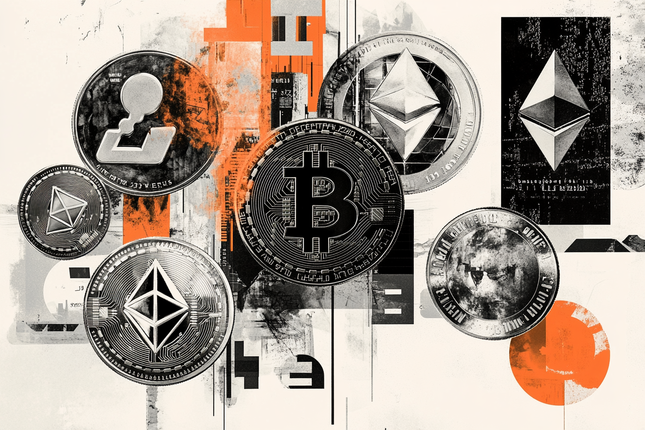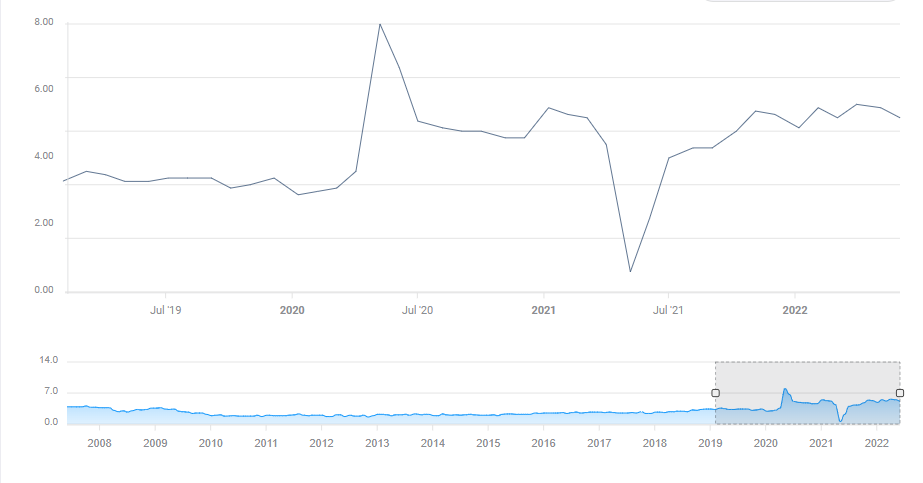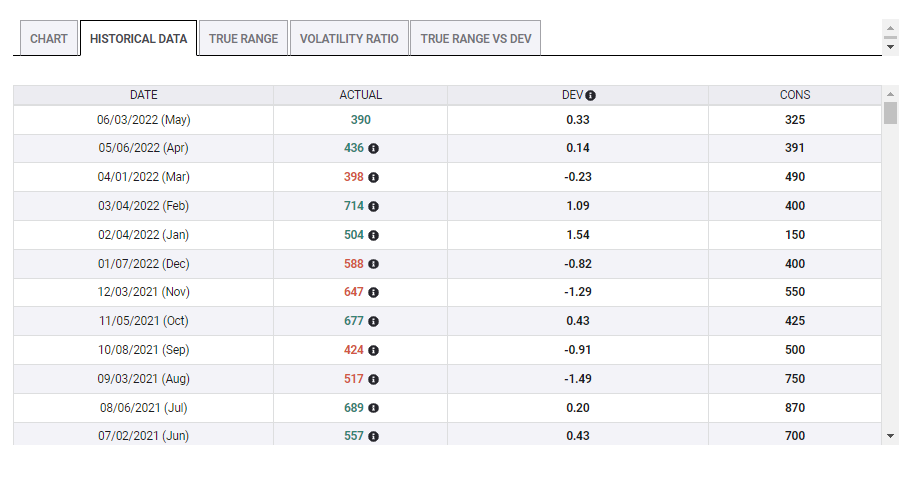- Stronger than expected job and wage growth would boost the dollar on rate hike projections.
- Weak employment expansion and high wages would also raise rate hike expectations.
- Downbeat figures in both would trigger safe-haven flows to the dollar.
- Only weak wages and robust labor growth would boost morale and weigh on the greenback.
Make the trend your friend – goes the old adage, and the wind is currently blowing in the dollar's sails. This is only one reason to favor seeing the greenback in the green. I will explain why only one combination of labor and wage growth could result in a dollar sell-off.
First, why are both the job and the headline Nonfarm Payrolls and Average Hourly Earnings important in the report for June?
In the previous one, wages stood out, as the Federal Reserve was laser-focused on inflation. Higher salaries mean more money in Americans' pockets – funds that impact a broad basket of goods. The Fed focuses on core inflation – everything excluding energy and food – that it can impact by discouraging lending and encouraging savings. It can hardly influence the price at the pump and strains in grain imports due to the war.
Average earnings have risen by 5.2% YoY in May and 0.3% MoM. The exact same figures are expected now – and salaries remain important for the same reasons:
Wage growth, like inflation, is above pre-pandemic trends:
Source: FXStreet
If wages rise at a faster pace, it would boost the dollar, almost regardless of the headline Nonfarm Payrolls change.
Yet that is not to say the main figure is unimportant, if anything the headlineNFP figure is returning to the fore. If the headline significantly misses estimates – 260,000 in June after 390,000 in May – then it would point to falling price pressures in the future. It would also shift priorities for the Fed.
America has been experiencing a robust labor market:
Source: FXStreet
While Fed Chair Jerome Powell stressed that inflation is a top priority, I want to stress that the central bank has two mandates, the second being full employment. If labor markets shrink, there is room for looser policy. However, that will not necessarily bring the dollar down.
Four scenarios
1) Stronger than expected figures: This is the most straightforward outcome. If America is hiring and pay is rising, it means the Fed must do more to cool the economy and prices. It would cement a 75 bps hike in July and raise expectations for the future. Dollar positive.
2) Weak job growth, high wages: Such a scenario would mean there are fewer low-paying jobs, but markets would ignore the reason and focus on what the Fed is leaning toward – inflation. The pain of a slower labor market would be ignored in favor of crushing rising prices. Higher interest rates would also result in a stronger dollar.
3) Downbeat data: If America hardly hires and salaries slow, it would lower rate hike expectations. However, "when the US sneezes, the world catches a cold." In other words, if the No. 1 economy cannot lead the world in growth, other economies would suffer even more. In such a case, it would be better to find refuge with the greenback. Safe-haven flows would boost the dollar.
4) Strong job growth, slower salary rises: In the pandemic era, a return of leisure and hospitality workers triggered a slide in wage growth. For markets, this would be a perfect scenario of robust economic expansion and lower price pressures. It would be both positive for the world and a sigh of relief for the Fed – a sign that prices would come down. For the dollar, it is the sole scenario in which it would slump.
Final thoughts
June's Nonfarm Payrolls will likely trigger more volatility than usual as uncertainty about the Fed's rate hikes has risen – and as currency markets seem more sensitive than usual to every piece of economic news. I want to remind newcomers to forex that trading tends to be choppy around the event. Trade with care.
Information on these pages contains forward-looking statements that involve risks and uncertainties. Markets and instruments profiled on this page are for informational purposes only and should not in any way come across as a recommendation to buy or sell in these assets. You should do your own thorough research before making any investment decisions. FXStreet does not in any way guarantee that this information is free from mistakes, errors, or material misstatements. It also does not guarantee that this information is of a timely nature. Investing in Open Markets involves a great deal of risk, including the loss of all or a portion of your investment, as well as emotional distress. All risks, losses and costs associated with investing, including total loss of principal, are your responsibility. The views and opinions expressed in this article are those of the authors and do not necessarily reflect the official policy or position of FXStreet nor its advertisers. The author will not be held responsible for information that is found at the end of links posted on this page.
If not otherwise explicitly mentioned in the body of the article, at the time of writing, the author has no position in any stock mentioned in this article and no business relationship with any company mentioned. The author has not received compensation for writing this article, other than from FXStreet.
FXStreet and the author do not provide personalized recommendations. The author makes no representations as to the accuracy, completeness, or suitability of this information. FXStreet and the author will not be liable for any errors, omissions or any losses, injuries or damages arising from this information and its display or use. Errors and omissions excepted.
The author and FXStreet are not registered investment advisors and nothing in this article is intended to be investment advice.
Recommended Content
Editors’ Picks

ECB reduces rates by 25 bps as largely expected – LIVE
On Thursday, the ECB delivered the 25 bps cut everyone expected, trimming the Deposit Facility Rate to 2.25%. EUR/USD remained within its daily sideline theme around the 1.1350-1.1360 band in the wake of the release. Now, all eyes are on Christine Lagarde’s live press conference as investors hang on her every word for clues about what comes next.

GBP/USD trades in an inconclusive fashion around 1.3230
GBP/USD is stuck in the 1.3250–1.3260 corridor on Thursday, maintaining a rangebound mood in response to the acceptable bounce in the Greenback and the generalised offered bias in the broad risk-linked galaxy.

Gold remains affered, recedes to the $3,340 area post-ECB
Gold powered to a fresh record, flirting with the $3,360 area per troy ounce, before embarking on a correction to the current $3,340 zone, always on the back of the decent rebound in the US Dollar and the recovery in US Treasury yields across the curve.

Crypto market cap fell more than 18% in Q1, wiping out $633.5 billion after Trump’s inauguration top
CoinGecko’s Q1 Crypto Industry Report highlights that the total crypto market capitalization fell by 18.6% in the first quarter, wiping out $633.5 billion after topping on January 18, just a couple of days ahead of US President Donald Trump’s inauguration.

Future-proofing portfolios: A playbook for tariff and recession risks
It does seem like we will be talking tariffs for a while. And if tariffs stay — in some shape or form — even after negotiations, we’ll likely be talking about recession too. Higher input costs, persistent inflation, and tighter monetary policy are already weighing on global growth.

The Best brokers to trade EUR/USD
SPONSORED Discover the top brokers for trading EUR/USD in 2025. Our list features brokers with competitive spreads, fast execution, and powerful platforms. Whether you're a beginner or an expert, find the right partner to navigate the dynamic Forex market.

